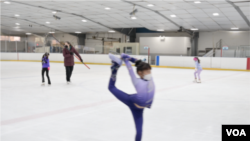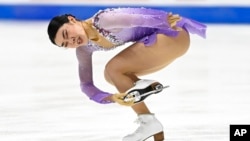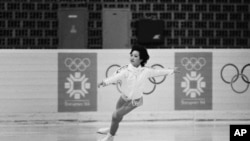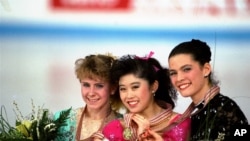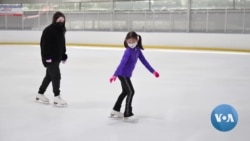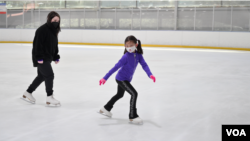Jumping, spinning and landing back on the ice, the young figure skaters at the Fairfax Ice Arena in a Washington, D.C., suburb have big dreams.
"My future goal is to reach the Olympics," said Sherry Naree Wester. The 8-year-old's mother is from Thailand, and her father is a white American.
"And I want a scholarship for college," said Jada Wong, 9. Her mom immigrated from Hong Kong, and her dad was born in a Chinese immigrant family in the United States.
The girls love the sheer beauty of figure skating, the sense of accomplishment that comes from completing challenging movements, and the fact that so many members of the 2022 U.S. Olympic Figure Skating Team are also Asian American.
"My favorite is Karen Chen. I like her combination spin of the layback and haircutter to Biellmann. And for her jump, I really like her triple lutz," said Wester, rattling off the technical names of moves that make arena audiences gasp, then applaud.
Inspiration is making representation a reality among Asian Americans in figure skating.
Nathan Chen, the first Asian American to win gold in men's figure skating, said that Michelle Kwan inspired him as a child. A five-time World Champion (1996, 1998, 2000, 2001, 2003) and a nine-time U.S. champion, (1996, 1998–2005), Kwan earned a silver medal at the 1998 Nagano Games and a bronze at the 2002 Salt Lake Games.
"For me, growing up in Salt Lake City and having a face like Michelle Kwan was really inspirational," said Chen at a victory press conference in Beijing.
"And I know that having athletes that look like you certainly gives you the hope that you can do the same, and Michelle Kwan certainly was that for me."
For the past two winter Olympics, the USA figure skating team has been dominated by Asian American athletes.
This year, four out of six figure skaters on the U.S. team are Asian American: Karen Chen, Nathan Chen, Alysa Liu and Vincent Zhou. Madison Chock, another Asian American, represents America in ice dancing. At the 2018 PyeongChang Winter Olympics, seven of the 14 U.S. figure skaters were Asian American.
Their presence has been decades in the making. Thirty-some years ago, Asian Americans were nearly nonexistent on the ice rink.
Tiffany Chin was the first Asian American to win the U.S. Figure Skating Championships in 1985.
Figure skater Kristi Yamaguchi was the first Asian American woman to win a gold medal in Winter Olympic competition when she finished first in women's singles at the 1992 winter games in Albertville, France. She also won two World Figure Skating Championships (1991 and 1992).
Susan Brownell, an anthropology professor at the University of Missouri-St. Louis who studies Chinese sports, and a former track and field athlete herself, told VOA Mandarin in an email that European American parents often prefer for their children to engage in physically harsher sports, for example football and baseball for boys, and soccer for girls. But Asian American parents don't value the aggressiveness and competitiveness of these sports.
"They are more concerned about their children facing injury, and they appreciate the aesthetic nature of figure skating. So they are more likely to encourage their children to take up figure skating," Brownell said.
"Over the last decade, the numbers of Asian Americans – some Japanese, but mostly Chinese – at the grassroots level (have) increased rapidly, and this has been feeding more and more Asian Americans into the development pipeline. All indications are that these numbers will continue to increase rapidly," she added.
Heidi Grappendorf, an associate professor of sport management at Western Carolina University, suggested that Asian Americans may see figure skating as a way into competitive sports.
"Figure skating provides a more welcoming and accepting atmosphere and culture without potential stereotypes than, for example, American football or even basketball," she said in an email to VOA Mandarin. Grappendorf added, "Stating that Asians are good at figure skating because of their body type is ridiculous and racist."
For every skater aiming high, the sport can punish a family budget. Brownell, who figure skates recreationally, told VOA Mandarin that costs for ambitious athletes add up with rink practice, coaching, clothing and equipment, club dues, competition entry fees and travel expenses quickly soaring to thousands of dollars annually.
Only a handful of top figure skaters have sponsorships, she added, and those competing internationally and nationally can apply for stipends from U.S. Figure Skating, the sport's national governing body. The organization provides a total of $750,000 annually, with stipends ranging from a few thousand dollars to as much as $40,000, according to Brownell's estimate.
And while Grappendorf suggested that because "Asian Americans' access to resources and income may be greater," costs are less likely to thwart aspirations, Brownell said that at her skating club, many working-class parents supported their children in the sport by holding down multiple jobs.
Wendy Zhai-Brown, whose 8-year-old daughter, Bethany Brown, takes pride in landing her jumps and finishing her spins correctly, said "Skating is indeed expensive, but it's not like Asians can afford it easily. We need to consider and balance different aspects of life."
She added, "I think, in general, Asians ... consider education as investment. Education is not just about what you learn from the textbooks in the classroom. Sports are a long-term investment in children's physical and mental well-being."
And any family with a figure skater in mix makes a significant time commitment to encourage their athletes, said Zhai-Brown, who left a job in commercial insurance to become a real estate agent so she could have a flexible schedule to meet her daughter's training timetable.
"I get up at 5:45 a.m. every day, prepare her breakfast and pack her lunch," said Zhai-Brown of her daily routine in suburban Virginia. "I wake Bethany up at 6:15, get to the ice rink at 7:20, and then she will do two practice sessions from 7:30 to 8:50. Then we basically run to the car and I'll drive her to school. Usually we will get there at 9:15, and 9:20 is the latest arrival time."
"So, it's a war every morning,"
Some kids, such as Sherry Naree Wester, return to the Fairfax Ice Arena to practice after school. They train every morning and afternoon, six days a week.
That practice, practice, and more practice attitude is the biggest determinant of success in figure skating, said Adriana DeSanctis, a coach at the Fairfax rink.
"The kids that are really succeeding are the kids that are on the ice all the time regardless of their race or ethnicity."




